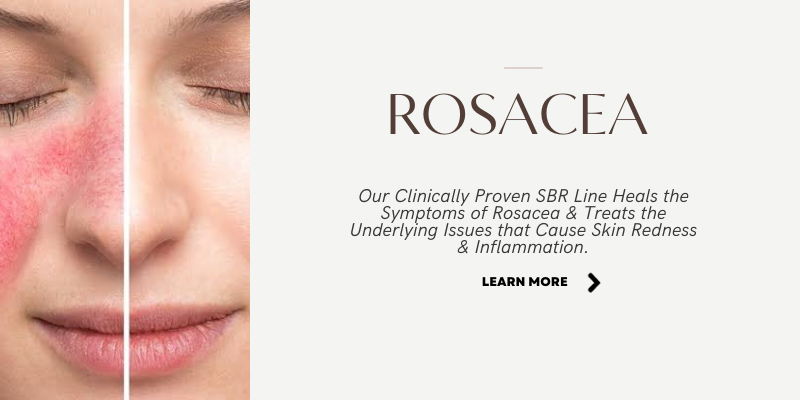If you think you have rosacea, getting accurate information and treatment is one of the most fundamental steps in achieving a healthier, and brighter and clear complexion. In the spirit of getting accurate information, let us help you find the source of your rosacea flares…
Rosacea flares are caused by triggers in the immune system. But what exactly is the source of these inflammatory triggers?
The latest finding by the National Rosacea Society points out that Demodex mites occur greater in number on the skin of rosacea patients than individuals who are not prone to the condition. The Journal of the European Academy of Dermatology and Venereology1 also finds there is a direct relationship between Demodex mites and several molecules that are responsible for causing inflammation in rosacea patients.
What Are Demodex Mites?
Demodex are actually a part of your skins’ natural microbiome (in other words microscopic) and are found in nearly 100% of humans past newborn age. These mites reside primarily in hair follicles, even the tiny blonde ones that are nearly invisible. Rebalancing your skins’ healthy skin microbiome is critical for control of rosacea. (What’s this – Read).
Another study2 found the pathogenic role of Demodex mites in rosacea patients. It says that the proliferation of these mites are a marker of rosacea and can be treated as an early sign of rosacea. Demodex competes with growth factors in your skin and causes immune response exhaustion to favor its own proliferation.
Result – your skin becomes inflamed, red, and irritated with a burning sensation, swollen bumps, visible blood vessels/ veins, and sometimes even enlarged nose. Demodex especially thrive in areas of increased oil production (like the T-Zone), as well as in clogged pores, with exposure to free radicals coupled with poor skin hygiene.
Solution? – Limit Potential Flares
Rosacea is a progressive, inflammatory skin condition and the sooner you address the problem with the right treatment, the better you can manage it. Depending upon your skincare and lifestyle management, Rosacea often cycles between periods of sensitivity coupled with inflammatory flares, and remissions (when there are lack of symptoms). It is definitely best (if possible) to start your Rosacea Skincare Regimen during the remission phase to avoid future flares and treat cutaneous neurogenic inflammation at its source. Treating during an active flare, when most people seek out something new in desperation, can actually cause further irritation unless the product is diluted. Read more..

With a lifespan of about 2-3 weeks, the Demodex population can be gently controlled with natural botanicals. Our SBR (Sensitive/Blemished/ROSACEA – Pitta) is a line-up of 4 important products:
- SBR Cleanser – 2X Daily
- SBR Hydrator/Toner – 2X Daily, or anytime your skin feels inflamed.
- SBR Serum (to be applied after BioScience Peptide Complex for better Anti-aging results) – 2X Daily, and
- SBR Papaya & Honey Facial Mask – 2-3X times a week.
Also use SunProtect SPF 30+ to avoid burning, redness and triggering more sensitivity by UV rays.
The calming and healing ingredients used in these formulas are 100% organic, natural, wild gathered, and made with USDA-approved ingredients. Comfrey (Allantoin) hydrates, soothes, and heals; White Willow Bark (naturally-extracted Salicylic Acid) calms inflammation and blemishes; Gotu Kola removes free radicals; Neem inhibits Demodex mites overgrowth. Oils of Grapeseed, Olive, and Apricot have concentrated amino acids and lipids to strengthen skin, retain elasticity, and improve clarity.
With 15+ years of proven results, these botanicals, along with dozens of other natural antioxidants, and anti-inflammatory agents in our SBR Line reduces sensitization, and provides results depending on where you start in the cycle, and your personal biology anywhere from an instantaneous calming effect to needing to dilute, but be assured of real, measureable results in 14-28 days.
Read More: An Interview with Real Life Rosacea Sufferer | FAQs on Rosacea.
References:
- Lee SG, Kim J, Lee YI, Kim J, Choi YS, Ham S, Lee JH. Cutaneous neurogenic inflammation mediated by TRPV1-NGF-TRKA pathway activation in rosacea is exacerbated by the presence of Demodex mites. J Eur Acad Dermatol Venereol2023;00:1-12.
- Fabienne M. N. Forton. Dermatol Ther (Heidelb). 2020 Dec; 10(6): 1229–1253. Published online 2020 Oct 23. doi: 10.1007/s13555-020-00458-9



